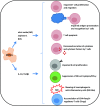Ageing and myeloid-derived suppressor cells: possible involvement in immunosenescence and age-related disease
- PMID: 25399072
- PMCID: PMC4233024
- DOI: 10.1007/s11357-014-9729-x
Ageing and myeloid-derived suppressor cells: possible involvement in immunosenescence and age-related disease
Abstract
Infections, cancer and autoimmune diseases occur more frequently in the elderly, and although many factors contribute to this, the age-related remodelling of the immune system, termed immunosenescence, plays a major role. Over the last two decades, studies have evaluated the effect of ageing on both the adaptive and innate arms of the immune system and demonstrated compromised function in several cells including lymphocytes (naïve, effector and memory), regulatory T and B cells, monocytes, neutrophils and NK cells. In addition, a well-documented feature of ageing is the increase in systemic inflammatory status (inflammageing), with raised serum levels of IL6, TNFα and CRP as well as reduced IL10. Recently, myeloid-derived suppressor cells have been the focus of many reports as these cells show immunosuppressive properties and are present in higher frequency during infections, cancer and autoimmunity. Importantly, there have been publications showing increased numbers of myeloid-derived suppressor cells in aged mice and humans. In this review, we discuss the current literature on myeloid-derived suppressor cells, their possible role in altered immune function in the elderly, and whether it may be possible to manipulate these cells to alleviate age-related immune dysfunction.
Figures
References
-
- Beerman I, Bhattacharya D, Zandi S, Sigvardsson M, Weissman IL, Bryder D, Rossi DJ. Functionally distinct hematopoietic stem cells modulate hematopoietic lineage potential during aging by a mechanism of clonal expansion. Proc Natl Acad Sci U S A. 2010;107:5465–5470. doi: 10.1073/pnas.1000834107. - DOI - PMC - PubMed
-
- Bingisser R, Tilbrook P, Holt P, Kees U. Macrophage-derived nitric oxide regulates T-cell activation via reversible disruption of the Jak3/STAT5 signaling pathway. J Immunol. 1998;160:5729–5734. - PubMed
Publication types
MeSH terms
Grants and funding
LinkOut - more resources
Full Text Sources
Other Literature Sources
Medical
Research Materials
Miscellaneous


